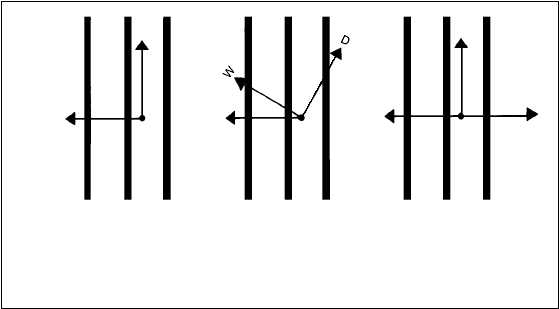involved. These other factors are the Coriolis effect,
frictional force, and centrifugal effect. When a unit of
air moves with no frictional force involved, the
movement of air is parallel to the isobars. This wind is
called a gradient wind. When the isobars are straight, so
only Coriolis and pressure gradient forces are involved,
it is termed a geostrophic wind.
Let’s consider a parcel of air from the time it begins
to move until it develops into a geostrophic wind. As
soon as a parcel of air starts to move due to the pressure
gradient force, the Coriolis force begins to deflect it
from the direction of the pressure gradient force. (See
views A and B of fig. 3-11). The Coriolis force is the
apparent force exerted upon the parcel of air due to the
rotation of Earth. This force acts to the right of the path
of motion of the air parcel in the Northern Hemisphere
(to the left in the Southern Hemisphere). It always acts
at right angles to the direction of motion. In the absence
of friction, the Coriolis force changes the direction of
motion of the parcel until the Coriolis force and the
pressure gradient force are in balance. When the two
forces are equal and opposite, the wind blows parallel
to the straight isobars (view C in fig. 3-11). The Coriolis
force only affects the direction, not the speed of the
motion of the air. Normally, Coriolis force is not greater
than the pressure gradient force. In the case of
super-gradient winds, Coriolis force may be greater
than the pressure gradient force. This causes the wind
to deflect more to the right in the Northern Hemisphere,
or toward higher pressure.
Under actual conditions, air moves around high and
low pressure centers toward lower pressure. Turn back
to figure 3-9. Here, the flow of air is from the area of
high pressure to the area of low pressure, but, as we
mentioned previously, it does not flow straight across
the isobars (or isoheights). Instead, the flow is circular
around the pressure systems.
The Coriolis force commences deflecting the path
of movement to the right (Northern Hemisphere) or left
(Southern Hemisphere) until it reaches a point where a
balance exists between the Coriolis and the pressure
gradient force. At this point the air is no longer
deflected and moves forward around the systems.
Once circular motion around the systems is
established, then centrifugal force must be considered.
Centrifugal force acts outward from the center of both
the highs and the lows with a force dependent upon the
velocity of the wind and the degree of curvature of the
isobars. However, the pressure gradient force is acting
towards the low; therefore, the flow in that direction
persists. When the flow is parallel to the curved portion
of the analysis in figure 3-9, it is a gradient wind. When
it is moving parallel to that portion of the analysis
showing straight flow, it is a geostrophic wind.
We defined pressure gradient as being a change of
pressure with distance. This means that if the isobars
are closely spaced, then the pressure change is greater
over a given distance; it is smaller if they are widely
spaced. Therefore, the closer the isobars, the faster the
flow.
Geostrophic and gradient winds are also
dependent, to a certain extent, upon the density of the
atmosphere and the latitude. If the density and the
pressure gradient remain constant and the latitude
increases, the wind speed decreases. If the latitude
3-11
W & PG
D
PG
PG
W
D
1004
1004
1004
1008
1008
1008
1012
1012
1012
PG = PRESSURE GRADIENT
D = DEFLECTING OR CORIOLIS FORCE
W = DIRECTION OF PARCEL OF AIR
A
B
C
AG5f0311
Figure 3-11.—Development cycle of a geostrophic wind.



